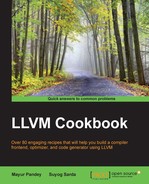In this chapter, we will cover the following recipes:
- Eliminating common subexpressions from machine code
- Analyzing live intervals
- Allocating registers
- Inserting the prologue-epilogue code
- Code emission
- Tail call optimization
- Sibling call optimization
The machine code generated so far is yet to be assigned real target architecture registers. The registers seen so far have been virtual registers, which are infinite in number. The machine code generated is in the SSA form. However, the target registers are limited in number. Hence, register allocation algorithms require a lot of heuristic calculations to allocate registers in an optimal way.
But, before register allocation, there exists opportunities for code optimization. The machine code being in the SSA form also makes it easy to apply optimizing algorithms. The algorithms for some optimizing techniques, such as machine dead code elimination and machine common subexpression elimination, are almost the same as in the LLVM IR. The difference lies in the constraints to be checked.
Here, one of the machine code optimization techniques implemented in the LLVM trunk code repository—machine CSE— will be discussed so that you can understand how algorithms are implemented for machine code.
